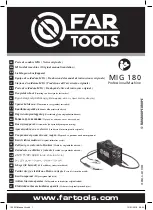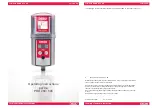
Fig.29 Abb.29
Fig.30Abb.30
RISCHIO DI SHOCK ELETTRICO
Non usare getti d'acqua, vapore (unità di lavaggio ad alta pres-
sione) e solventi o vernici nelle immediate vicinanze del solle-
vatore e prestare particolare attenzione a mantenere tali so-
stanze lontano sul pannello di comando elettrico.
RISCHIO DI GUASTO DI UN COMPONENTE
DURANTE IL FUNZIONAMENTO
Il produttore ha fatto uso degli idonei materiali e tecniche di co-
struzione relative all'uso specificato della macchina al fine di
produrre un sollevatore affidabile e sicuro. Va tuttavia sottoline-
ato che il sollevatore deve essere usato in conformità alle pre-
scrizioni dei produttori e ci si deve attenere alla frequenza delle
ispezioni e dei lavori di manutenzione raccomandata nel
capitolo 6 "MANUTENZIONE".
RISCHI CORRELATI AD UN USO IMPROPRIO
Le persone non possono stare in piedi o sedute sulle piattaforme
durante la manovra del sollevatore o quando il veicolo è già solleva-
to (fig.30). Ogni utilizzo del sollevatore diverso da quelli per cui è
stato progettato potrebbe provocare seri incidenti alle persone che
lavorano nelle immediate vicinanze dell'unità. Pertanto è essenziale
attenersi scrupolosamente a tutte le norme che trattano l'uso, la ma-
nutenzione e la sicurezza contenute in questo manuale.
ISTRUZIONI DI SICUREZZA PER LA
MANUTENZIONE
1. I lavori di manutenzione o riparazione devono essere effet-
tuati solo da personale autorizzato.
2. Spegnere e chiudere con un lucchetto l'interruttore principale pri-
ma di effettuare qualsiasi lavoro di manutenzione o riparazione.
3. Il lavoro su componenti elettrici o interruttori di prossimità deve
essere effettuato esclusivamente da personale autorizzato.
4. I lavori sulle apparecchiature elettriche devono essere effet-
tuati esclusivamente da elettricisti qualificati
5. Non sostituire o bypassare i dispositivi di sicurezza.
6. Accertarsi che lo smaltimento delle sostanze pericolose per l'am-
biente sia effettuato in modo conforme alle norme appropriate.
RISK OF ELECTRIC SHOCK
Risk of electric shock in areas of the lift housing electric wiring. Do not
use jets of water, steam (high pressure wash units), and solvents Or
paint in the immediate vicinity of the lift, and take special care to keep
such substances clear off the electrical command panel (Fig.29).
RISK OF COMPONENT FAILURE DURING
OPERATION.
The manufacturer has used appropriate materials and construction
techniques in relation to the specified use of the machine in order
to manufacture a reliable and safe lift. Note however, that the lift
must be used in conformity with the manufacturers prescriptions
and the frequency of inspections and maintenance work recom-
mended in chapter 6 “MAINTENANCE” must be observed.
RISK RELATED TO IMPROPER USE
Persons are not permitted to stand or sit on the platforms during
the lift maneuver or when the vehicle is already lifted (Fig.30). All
uses of the lift other than the uses for which it was designed are
liable to give rise to serious accidents involving the persons wor-
king in the immediate vicinity of the unit.
It is therefore essential to adhere scrupulously to all regulations re-
garding use, maintenance and safety contained in this manual.
SAFETY INSTRUCTIONS FOR SERVICING
1. Maintenance or repair work by authorized service personnel only.
2.Turn off and padlock the main switch before doing any mainte-
nance,or repair work.
3. Work on pulse generators or proximity switches by authorized
service personnel only.
4. Work on the electrical equipment by certified electricians only.
5. Do not replace or override the safety devices.
6. Ensure that ecologically harmful substances are disposed of
only in accordance with the appropriate regulations.
31
Summary of Contents for 209I/B
Page 2: ......
Page 61: ......
Page 62: ...STRUTTURA PRINCICPALE 380 MAIN STRUCTURE 380V ...
Page 63: ...COLONNA COMANDO 380 MAIN COLUMN 380V ...
Page 64: ...QUADRO ELETTRICO TRIFASE 380V THREE PHASE CONTROL PANEL 380V ...
Page 65: ...CENTRALINA OLEODINAMICA 380V OLEODYNAMIC CONTROL UNIT 380V ...
Page 66: ...STRUTTURA PRINCICPALE 220 MAIN STRUCTURE 220V ...
Page 67: ...COLONNA COMANDO 220 MAIN COLUMN 220V ...
Page 68: ...QUADRO ELETTRICO MONOFASE 220V MONO PHASE CONTROL PANEL 220V ...
Page 69: ...CENTRALINA OLEODINAMICA 220V OLEODYNAMIC CONTROL UNIT 220V ...
Page 70: ...BASAMENTO CHASSIS ...
Page 71: ...CILINDRO CYLINDER ...
Page 72: ...CARRELLO PRINCIPALE MAIN CARRIAGE ...
Page 73: ...CARRELLO SECONDARIO SUB CARRIAGE ...
Page 74: ...BRACCIO LUNGO LONG ARM BRACCIO CORTO SHORT ARM ...
Page 76: ...COLONNA SERVIZIO SUB COLUMN ...















































